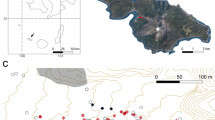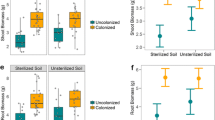Abstract
Field experiments were carried out to investigate influences of seasonal change on the fungal succession occurring on the surface of decaying pine needles at a moder site in Japan. At different seasons, the needles fallen for a short period were collected and marked, then placed on the surface of the O horizon. The needles were removed at intervals and their fungal communities were examined by using a washing technique. Unlike the successions of interior colonizers studied at the same time, those of surface colonizers observed on the fallen needles at four different times are roughly similar to each other.Thysanophora penicillioides was the major first colonizer on the sample needles from the O horizon, andTrichoderma species followed it. In an experiment started in late autumn, three dematiaceous fungi,Chloridium viride var.chlamydosporis, Sporidesmium omahutaense, andChalara sp., commonly occurred and contributed to the darkening of colonized needles. Seasonal variation in climate may have a stronger effect on internal colonizers than external colonizers of needles.
Similar content being viewed by others
Literature cited
Aoki, T., Tokumasu, S. and Oberwinkler, F. 1992. Fungal succession on fir needles in Germany. Trans. Mycol. Soc. Japan33: 359–374.
Aoki, T., Tokumasu, S. and Tubaki, K. 1990. Fungal succession on momi fir needles. Trans. Mycol. Soc. Japan31: 355–374.
Ellis, M. B. and Ellis, J. P. 1985. Microfungi on land plants, p. 76. Croo Helm, London.
Gourbière, F. 1979. Les champignons microscopiques liés aus aiguilles de sapin (Abies alba Mill.). 4. Microflore de la littère. Bull. Soc. Mycol. Fr.91: 429–441.
Harley, J. L. and Waid, J. S. 1955. A method of studying active mycelia on living roots and other surfaces in the soil. Trans. Br. Mycol. Soc.38: 104–118.
Hudson, H. J. 1968. The ecology of fungi on plant remains above the soil. New Phytol.67: 837–874.
Kendrick, W. B. and Burges, A. 1962. Biological aspects of the decay ofPinus sylvestris leaf litter. Nova Hedwigia4: 313–342.
Lehmann, P. F. and Hudson, H. J. 1977. The fungal succession on normal and urea-treated pine needles. Trans. Br. Mycol. Soc.68: 221–228.
Mitchell, C. P. and Millar, C. S. 1978. Mycofloral succession on Corsican pine needles colonized on the tree by three different fungi. Trans. Br. Mycol. Soc.71: 303–317.
Parkinson, D. and Balasooriya, I. 1967. Studies on fungi in a pine-wood soil. I. Nature and distribution of fungi in the different soil horizons. Rev. Écol. Biol. Sol.4: 463–478.
Soma, K. and Saitô, T. 1979. Ecological studies of soil organisms with references to the decomposition of pine needles I. — Soil macrofaunal and mycofloral surveys in coastal pine plantations. Rev. Écol. Biol. Sol.16: 337–354.
Tokumasu, S. 1978. Leaf litter fungi of the forests ofPinus densiflora and four introduced pines at Sugadaira, central Japan. Trans. Mycol. Soc. Japan19: 383–390. (In Japanese).
Tokumasu, S. 1980. Observations on the fungal flora in the pine leaf litter. In: Biseibutunoseitai, vol. 7, (ed. by Biseibutsuseitaikenkyukai), pp. 129–144. Gakkai Shuppan Center, Tokyo. (In Japanese).
Tokumasu, S. 1996. Mycofloral succession onPinus densiflora needles on a moder site. Mycoscience37: 313–321.
Tokumasu, S. 1998. Fungal successions on pine needles fallen at different seasons: the succession of surface colonizers. Mycoscience39: 409–416.
Tokumasu, S., Aoki, T. and Oberwinkler, F. 1994. Fungal succession on pine needles in Germany. Mycoscience35: 29–37.
Tubaki, K. and Saitô, T. 1969.Endophragmia alternata sp. nov. and other Hyphomycetes onPinus leaves in Japan. Trans. Br. Mycol. Soc.52: 477–482.
Widden, P. 1984. The effects of temperature on competition for spruce needles among sympatric species ofTrichoderma. Mycologia76: 873–883.
Widden, P. and Hsu, D. 1987. The effects of temperature and litter types on competition betweenTrichoderma species. Soil Biol. Biochem.19: 89–93.
Widden, P. and Parkinson, D. 1973. Fungi from coniferous forest soils. Can. J. Bot.51: 2275–2290.
Widden, P. and Scattolin, V. 1988. Competitive interactions and ecological strategies ofTrichoderma species colonizing spruce litter. Mycologia80: 795–803.
Author information
Authors and Affiliations
Additional information
Contributions from Sugadaira Montane Research Center, No. 165.
About this article
Cite this article
Tokumasu, S. Fungal successions on pine needles fallen at different seasons: The succession of surface colonizers. Mycoscience 39, 417–423 (1998). https://doi.org/10.1007/BF02460902
Accepted:
Issue Date:
DOI: https://doi.org/10.1007/BF02460902




